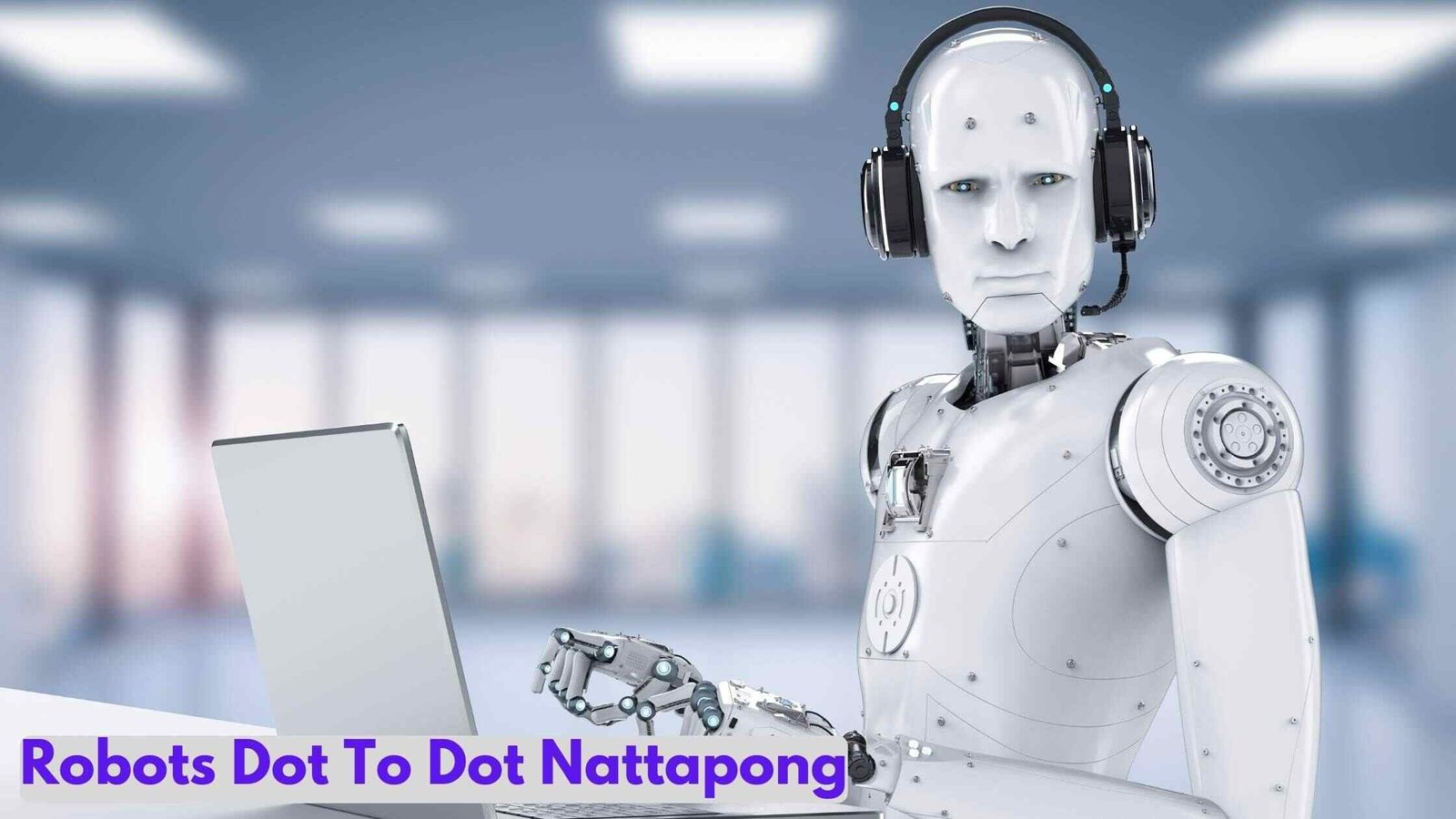One name sticks out above the others in a world where robots are more present in daily life: Robots Dot to Dot Nattapong. This creative firm is pushing the envelope and developing cutting-edge technology that is altering the way we think about robotics and intelligent automation. Come explore how Robots Dot to Dot Nattapong is influencing automation in the future and revolutionizing global industries.
Nattapong: What is it?
Thai artist Nattapong is well-known throughout the world for his dot-to-dot paintings. He was always fascinated by the interfaces between human creativity and technological precision. The communities of invention and craftsmanship questioned Nattapong’s early experiments. This inspired him to pursue a career in visual arts and mechanical technology, which together would eventually give rise to his distinctive style.
The communities of invention and craftsmanship questioned Nattapong’s early experiments. Many claimed that only human hands, not robots, could produce truly great art. Nattapong, however, disregarded and upheld the idea that, rather than taking the place of humans, technology can also be a tool for fostering human creativity.
Robotics’ Past Nattapong, dot to dot:

A series of numbered dots make up the problem known as “connect the dots” (sometimes called “follow the dots,” “connect-the-dots,” and so on). The practice of joining dots to form images or support calligraphy dates back to the 1800s. The first known puzzle game where the goal is to connect dots to solve a logic puzzle rather than to draw a picture is called the Nine Dots Puzzle. Early in the 20th century, the printed press began to publish connect-the-dots games. On the Sunday edition, they were released for the younger audience. However, Ward, Lock & Co. printed the first book with the game solely in 1926.
An Overview of Dot to Dot Nattapong Robots and Their Creator:
Robots Dot to Dot Nattapong is a revolutionary invention that promises to transform the robotics and automation business. It’s a step into the future! This cutting-edge technology, developed by visionary innovator Nattapong Thammasan, is revolutionizing intelligent automation. Let’s explore how Robots Dot to Dot Nattapong is changing our perception of what robots are capable of.
Robots in Production: Accuracy and Efficiency
The manufacturing industry was one of the first and most notable to use Robots Dot to Dot Nattapong. Historically, physical labor—which was frequently prone to mistakes and inefficiencies—was a major component of manufacturing. The industrial robot revolution has completely changed the production environment.
Robots’ Place in Assembly Lines:
Production processes have been changed by robots on assembly lines. These robots, which come with sensors and precision tools, can complete jobs like welding, painting, and assembling with unmatched accuracy and speed. This guarantees consistent quality in manufacturing in addition to increasing productivity.
Robots: Dot-to-Dot Nattapong Essential Elements:

Here are a few intriguing aspects of Nattapong that you should be aware of:
- Kits for Education:
The platform provides kits with components and pre-designed templates that are helpful for pupils. They are able to construct a dot pattern. Each dot on the robot indicates a specific component or link.
- Interactive Educational Resources:
A wide selection of interactive and digital books are available. These are the ideal addition to the kits. These include fascinating facts, step-by-step instructions, and more.
- Classes and Workshops:
It holds classes and workshops to encourage student participation. Under guidance, attendees can produce robotics projects. They can seize the chance for exclusive encounters and fast feedback.
- Internet-Based Community:
Nattapong is aware of the value of community members’ assistance. He developed a website that teachers and students can use. They are able to collaborate and share initiatives. The goal of nattapong is to maximize the sense of belonging.
Advantages of Robotics Education’s “robots dot to dot” nattapong approach:
- Simplified Education:
Subdivisions facilitate students’ ability to work on a tiny portion of a system at a time, making learning less difficult and more manageable.
- Increased Involvement:
Students find it easier to participate actively in class as a result of this. Building a physical robot assembly not only piques interest in robotics but also makes it feasible to have a working robot.
- Enhanced Ability to Solve Problems:
In the classroom, these kinds of dot-to-dot pattern practice can be quite effective. As they are guided to cultivate, they receive training on how to identify issues and discover solutions.
- More Effective Concept Retention:
The dot-to-dot method also has the benefit of walking students through each step to make sure they comprehend everything, which results in solid fundamental knowledge for robots.
- Including all:
Because Nattapong aims to serve all students, the lessons are appropriate for students of all ages and skill levels. From here, it is simple to discover that the dot-to-dot method makes it possible to easily acquire the fundamentals of robotics, regardless of prior robotics knowledge.
- Practical Uses:
This is how the method enriches the learning experience for the students by providing them with real-world examples. These competencies provide a foundation for engineering and technology majors and are highly helpful in complicated projects and competition participation.
Robot Types: Dot-to-Dot Nattapong Exercises:
On Robots Dot to Dot Nattapong, you will find the following categories:
- Basic Robots with Dots to Dots:
These exercises are distinguished from the later challenges by having fewer dots and simpler forms, as they are formally designed to teach beginners or younger kids.
- Advanced Robots with Dots:
However, because these designs are intended for enhanced users, they present a somewhat greater challenge that requires more concentration and accuracy to complete.
- Dot-to-Dot Robots with Themes:
These exercises include robot models that can be chosen based on a theme or any character of one’s choosing, which adds creativity to the practice.
- Dot-to-Dot Learning Robots:
Users enjoy these enjoyable activities, which are followed by a series of questions that acquaint them with various facets of the robot, such as its functioning or anatomy.
- Digital Dot-to-Dot Robots that Interact:
Modern adaptations of dot-to-dot are also available; these interactive versions of the game are as entertaining. The drawings can be produced on digital devices and filled in using augmented reality.
How to Begin?
It’s simple to get started with Robots Dot to Dot by Nattapong. The steps are as follows:
- Select Your Puzzle:
Choose a puzzle based on your degree of expertise. More seasoned puzzlers can tackle the more complicated designs, but beginners can start with the simpler ones.
- Assemble Your Supplies:
Pencil and eraser are all you need. Have some colored pencils or markers ready if you want to add some color to your finished robot.
- Join the Dots:
Commence at dot number one and proceed according to the order. Go slowly and enjoy the procedure.
- Include the last touches:
After making all the necessary connections, you may color your robot and add any further details you choose.
How to Appreciate Robots Dot to Dot?
- Take Your Time: Take your time solving the problems. The fun lies in seeing the robot come to life as you join the dots.
- Think Outside the Box: Please feel free to customize the final robot with your own touches. Perhaps it has a feature you can’t conceive or a distinctive color palette.
- Distribute to Friends: Playing this game with loved ones makes it even more enjoyable. Your finished robots can be compared, and you can even write a brief narrative about them.
The Impact on Society and Ethical Issues:
Even while “Robots Dot to Dot Nattapong” has many advantages, its widespread use presents moral questions and has societal ramifications. The need for responsible innovation is highlighted by worries about data privacy, ethical decision-making in AI systems, and the loss of jobs due to automation. It is critical to confront these issues head-on as technology develops in order to make sure that robotics improves society well-being while maintaining moral principles and protecting individual rights.
“Robots Dot to Dot Nattapong: The Future”
In the future, “Robots Dot to Dot Nattapong” could lead to more breakthroughs and significant changes. Swarm robotics, which facilitates cooperative efforts in disaster response, enhanced humanoid robots with complex interactions and emotional intelligence, and AI-driven advancements that improve human-machine collaboration are examples of potential future breakthroughs. New horizons in robotics are opening up as engineers and researchers push the boundaries of the field, opening the door to a future where technology will profoundly benefit humans in more ways than one.
In summary:
Students benefit from this interactive learning approach from an early age. Students’ interest in new technologies will grow as a result of robotics education. Additionally, it enhances brain function. Robots Matching Each Other Playing nattapong with young children is a beneficial way to help them develop their skills.

